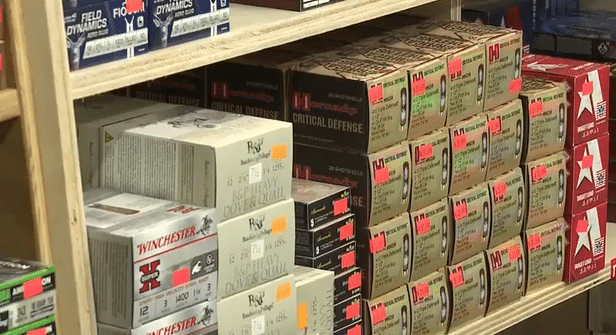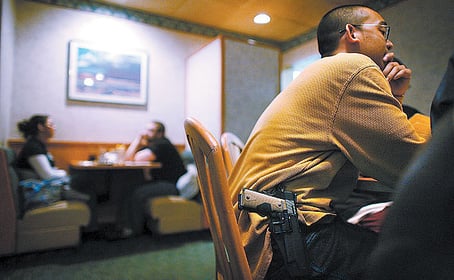A lot of focus is placed on the idea “what is good enough” when it comes to shooting a concealed carry handgun. However, some of that focus may be misdirected. Unlike firing for practice at the range, the emphasis isn’t necessarily on a tight shot grouping as much as it is becoming comfortable with drawing from your concealed carry holster and maintaining situational awareness.
In this article, we’ll discuss several reasons why “good enough” needs to apply to more than just shot groupings.
Get Your Concealed Carry Draw Down
People who have plenty of experience at the range may not be the best prepared for concealed carry. Paper targets don’t move. In most cases, living people do. The whole reason for a self-defense handgun is to hit an active threat to your life.
Would you stand in one place and exchange bullets with a bad guy?
Here’s a couple training practices to get you into the grove of getting used to drawing from your concealed carry holster.
Exercise 1: Spot The Target, Draw, Fire, Then Secure
- Place your hand on your handgun in its holster.
- Scan your full field of view.
- Lock on target.
- Draw your pistol or revolver from its holster.
- Instinctively put two rounds center mass on the target.
- Scan your full field of view.
- Place your handgun back in its concealed carry holster.
When is it good enough? The basic idea is that if you are able to reduce extraneous movement (wiggling, adjusting) on the draw, quickly thrust your handgun onto target, and then secure the pistol – you’re on the right track.
Shot groups are not nearly as important as developing the mechanics of your reaction. Your reaction speed is the first priority. Tight 6″ shot groupings at 5 yards is the second. Why 6 inches? If you’re able to place two shots center mass into a target with your concealed carry handgun – while doing all the above things in a timely fashion – you’re doing pretty good.
It may take a long time to develop these skills. Focus first on getting the motions down so comfortably you can do them without looking anywhere but your intended target. Feel free to run dry fire drills to develop the rough mechanics and then take it to the range for active practice.
Remember: always inspect your firearm to ensure it is unloaded before dry firing. This means ejecting the magazine and inspecting the breach for brass.
Exercise 2: Spot Target, Draw, Fire, Reload, Fire, Secure
This exercise incorporates one additional step from the first exercise: changing a magazine.
- For this exercise, load two magazines with two bullets each.
- After you draw your pistol and fire at the first target, eject the first magazine and insert the second.
- Place two more rounds on target before concluding the exercise.
Exercise 2 takes an additional step that develops an important skill: getting used to changing magazines. No matter the capacity of your concealed carry pistol (or revolver), you should always feel comfortable reloading.
If you’re able to develop a level of comfort with these two exercises, a third one will be extremely beneficial if you have a range that will allow it.
Exercise 3: Move Between Two Targets
This is a more advanced exercise but essential nonetheless. We, as concealed carriers, should never assume there is only one threat. Just as important as being relaxed, controlled, and fast about the first two exercises – a third one should ideally incorporate more than one target.
Only attempt this exercise if you are operating on a range that allows it and if you’re following the four fundamental principles of firearm safety. It’s okay to put both targets at the same distance and a recommended beginner’s distance is around 10 yards.
If you have these skills and techniques down, we’ll be writing some future articles on combat pistol drills to improve your reaction time.






![[LIGHT REVIEW] ACEBEAM Defender P15 Is Going To Light Up Your World](https://imagedelivery.net/sbm_lYeJbALkepJgtmRD5w/concealednation.org/2021/11/Acebeam-defender-P15-light-review_10.jpg/w=728,h=381)



![[FIREARM REVIEW] Ruger LCP II; The New Look Of The LCP](https://imagedelivery.net/sbm_lYeJbALkepJgtmRD5w/concealednation.org/2016/11/Images900001-1.jpg/w=728,h=381)


![[OP-ED] If Trump Favors Gun Free Zones — Start With His Own Hotels?](https://imagedelivery.net/sbm_lYeJbALkepJgtmRD5w/concealednation.org/2015/08/alg-donald-trump-jpg.jpg/w=728,h=381)
![[BREAKING] Emily Miller: DC Police Chief Tells Force To Allow Full Reciprocity For Concealed And Open Carry](https://imagedelivery.net/sbm_lYeJbALkepJgtmRD5w/concealednation.org/2014/04/1top-photo.jpg/w=728,h=381)